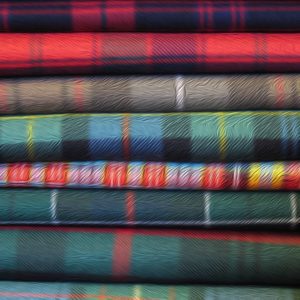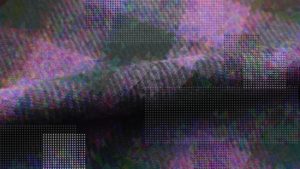
It’s heavier than I thought it would be, and stiffer. The cotton drill fabric has the feel of an army jacket. The snaps and clasps and buckles have a certain sensuality, a resonance of kink, but otherwise, in color and heft, the garment is as ordinary as any one of the many pairs of pants hanging in my closet.
So why am I so nervous to put it on?
I received this utility kilt as a birthday gift from my friend Harry, who had noticed how awestruck I was after viewing the exhibit Camp: Notes on Fashion at the Metropolitan Museum of Art and thought I would be delighted by this tiny step into gender fluid fashion. But when I pulled the plastic bag out of its mailing package and saw the pleats of the black kilt folded inside, I immediately scrunched the bag, unopened, back into the mailer and shoved it quickly under the sweaters in my dresser drawer, like it was porn I was trying to hide. It surprised me, how reflexively taboo it felt to even possess a kilt, let alone put one on. I’m a gay man who’s been out for decades. I’ve written novels centering queerness. Who better to wear a kilt?
This fear is largely generational, I think, and deeply ingrained. For most of my life, the idea of wearing a skirt would be unthinkable. It’s a carryover from coming out in the ’80s, when all our parents’ fears and revulsion surrounding homosexuality coalesced around one central image: their boy in a dress. Behind every parent’s nervous eyes when their son sat them down and finally came out— this question: Are you going to start wearing women’s clothes? That was largely what they understood being gay to be at that time: wanting to be a woman. I remember when my husband and I adopted a child from Vietnam, his folks were dead set against it. “We don’t know what they do in their own homes,” his mother said privately to my sister-in-law, “Maybe they wear dresses all day.” As if that were the worst transgression in the world, as if wearing a simple shift were the ultimate form of child abuse. Unfortunately, in our quest to reconcile our parents to our sexuality, a lot of us tethered ourselves to the status quo: I’m just the same person I always was. Don’t worry, I’m gay, but not that kind of gay.
It didn’t help that I came out just as AIDS was entering public consciousness; my introduction to sex arrived almost exactly at the same time as the knowledge that it could kill you. Coming out was one of the most freeing experiences of my life, but ironically it was accompanied by a vital need for caution and vigilance. Forget about free love, exploration, adventure— it was enough to stay alive. We found ourselves confronted not only with an epidemic, but an administration who would not acknowledge its existence, let alone offer any kind of medical guidance, funding, or research (it would take President Reagan four years to even name the disease publicly, by which time thousands had already died). The mainstream path to gay rights and, later, marriage rights, was one of demonstrating that we were worthy of acknowledgement; that we had the same values, the same needs, as the straight world. We weren’t frightening, diseased predators, but your neighbors! Your sons! We wear khakis and polo shirts! Gays: they’re just like us!
Of course, there were gay men who didn’t conform in order to fight for their rights, who managed to remain as fierce and unique as they wanted to be. But that wasn’t me. I’m a first generation Chinese American, the only son of a Shanghainese father who demanded duty and deference as well as excellence, and an Italian stepmother, also an immigrant, who always stressed the importance of bella figura—acting and appearing just so in public. I was a model student (see above father) and a middle child—I’m bred for obedience. Also, at that time, there was no celebrating cultural differences; the directive of the day was Assimilate! It wasn’t easy— as only one of two Asian students in my grade school (Ann Yih and me, shooting daggers at each other from across the room), I already stood out too much. But I did my best. I always tried to be a kid who blended in, “a brown moth against bark,” as a character in one of my books describes himself. It’s second nature. It’s Who I Am.
Or—is it?
About a month after receiving the kilt, I’m standing in my bedroom as guests are waiting downstairs with my husband to celebrate the new year. It’s the perfect occasion: safe in my own home, with only a few close friends in attendance, one of whom is Harry. Still, I hesitate. What will it say about me? What will people think? I don’t have questions about my gender, or my expression of it. I’m not anywhere near what you would call fashionable; my husband says my closet is a rainbow of colors, all dun. I’m not one of those gorgeous, thin models sporting androgynous looks on the runway, or those shirtless gym boys, booted, bronzed, and shaved, dancing on pride parade floats. I am a gay Asian man of a certain age, bespectacled, avuncular, decidedly not Scottish. Who am I to wear this kilt?
Time ticks away, and a mild recklessness kicks in. Maybe it’s decision fatigue. I wrap the kilt around me like a spa towel. Buckle and snap the hardware. Pull on my boots. Walk down the stairs, kilt swaying, heart racing, and make my grand entrance. Twirl. The reaction? Huzzahs, compliments, and . . . that’s it. We have our dinner and play our games and toast the ball dropping down and me wearing a kilt is so not a big deal.
Except . . . it is. I feel transformed. I can’t wait to wear it again.
As far as gender-expansive exploration of clothing is concerned, kilts are a relatively easy reach. They’re a historical symbol of Scottish rebellion and badassery, conjuring images of bravery and warfare and the muscled calves of Outlander’s Sam Heughan. The company who makes my utility kilt certainly lean into this narrative—their website, when I click on it, is filled with burly, bearded men astride tractors and logs, bare-chested, tattooed and mud-streaked, wielding battle axes and hammers, glowering. Lots of glowering. You’d be forgiven for mistaking the site for a rugby aficionado page. The company is reassuring its customers: “Don’t worry, this isn’t a skirt, not at all, it’s a KILT. Manly, okay? MANLY men wear these things.” Even the name kilt is percussive and brutal, echoing the word “kill.” Not a skirt. Kilt.
I must not be the target demographic for this company, but I buy two more kilts anyway, one gray, one brown—a man needs choices. I wander over to the “Women’s Kilts” page and find that the only differences in this inventory are their length (better for my shorter legs) and choice of colors. Impetuously, like I’m gaming the system, I add a plum kilt to the shopping cart, too.
Kilts are the gateway skirt for men.
I choose the Hollywood Farmers’ Market for my first public appearance en kilt. There’s this little jump of anxiety I feel as I walk from my car, an inner freezing that continues before every potential encounter. It reminds me of the first time I used the word “husband” at the dry cleaners after getting married in 2008, when the older Korean woman at the counter said, “Will you be picking it up, or your… friend?” and I froze, then stammered out, “Yes, my, uh… husband will be coming by.” A completely normalized answer now, but back then, when national marriage equality rights were still hotly debated, it felt like a statement, a challenge. It was a new coming out, so long after that initial one in college. And here at the market—another coming out. Walking up to produce carts and food stands, I get this same ping of both apprehension and defiance. I find myself affecting a loose swagger, head up, a confidence that’s not exactly real, as if to say, “Look at me! I’m the kind of person who can wear this! I’m carrying it off!”
I’m mostly met with studied indifference, no one pointing or staring, which is to be expected—it’s just a kilt in Los Angeles, after all. The funny thing is that, after I’m there for a bit, the swagger does become more real. I am carrying it off! One vendor asks if it’s for a special occasion. Another compliments the sweater/skirt combo I’m sporting. And, of course, there’s the inevitable, “Is it true what they say? About what’s underneath your kilt?”
I’ll never tell. But it’s worth asking: what is underneath my sudden shift into kilts?
I know this: I love the way wearing a skirt feels. I love how the fabric moves, the touch of coolness above your knees, like a kiss. How the air circulates beneath you as you walk, the freedom of movement. I love that twirl. I even love my shadow in the lamplight when I walk the dog at night, watching the sway of the skirt, a new silhouette. My pants stifle in comparison, little leg prisons. And okay, maybe I do feel a little more subversive in kilts, a little more stylish. Empowered. But mostly, they’re just so damn comfortable.
(Wait. See what I did right there? Even here, I’m trying to justify, to mediate my desire, as if I can’t just want to wear them; I have to give a reasonable, Average Joe explanation as to their presence on my body.)
It’s odd that my wearing a skirt has to signify anything. Why should a piece of clothing with one opening instead of two be ascribed to a specific gender or sexuality? Why is a kilt marginally more acceptable on men, but not a Gap modal A-frame mini?
That perception may be changing. Yes, I know: every year the fashion pundits proclaim it the Year of Men in Skirts, but it could actually happen. The separation of gender from gender expression has created an opening for all kinds of exploration. Rock stars and rappers are wearing dresses, Instagram is awash in #meninskirts posts, and most significantly, this next generation of young adults seem so much more relaxed in how they present themselves. Doing research for my novel about queer teens, I’ve learned to admire the younger generation’s fearlessness, their reflexive activism, their ease in living in a not-knowing space when it comes to sexuality and gender and gender expression. I’d been working most of my life on acceptance, fighting for gay marriage, the right to raise a child without fear in a Modern Family-type household, but while I was swimming in the mainstream there has been this other current underneath, vibrant and diverse and fluid. This discovery comes at a time when I’m approaching the age of having no more fucks to give, and it’s inspiring seeing kids who so much earlier have decided that they weren’t giving any fucks either.
Maybe that’s what it is: wearing kilts has changed more than my wardrobe; it’s changed my attitude. It’s opened me up to explore myself in a way I haven’t done in a long time: Who I am, What I am— beyond the fixed parameters of convention and conformity. It’s a liberation that I haven’t felt since coming out all those decades ago. I feel more queer in skirts, queer in the best possible way. Queer as in free.
I’m in kilts about half the time. My closet has all these pops of color now, sprouting from the dun like a desert during the blooming season. I’ve made tentative steps beyond utility kilts; it’d be nice to have lighter options for the summer, without all the clasps and buckles and hardware, something that…flows? It’s opened up a whole new avenue of shopping, and a whole new language— A-line, panel, gathered, tiered—the semantics of skirts. ` I’m still not entirely comfortable shopping in the women’s section of department stores (though I did recently purchase an open front draped cardigan at Nordstroms that I think will look swell on me). It’s not always easy to be displaying myself after a lifetime of hiding on brown bark. But it’s worth it. I used to think people dressed against the norm in order to be seen, to be looked at. And that could very well be true, but maybe it’s also possible that we are dressing that way because we want to see ourselves.






